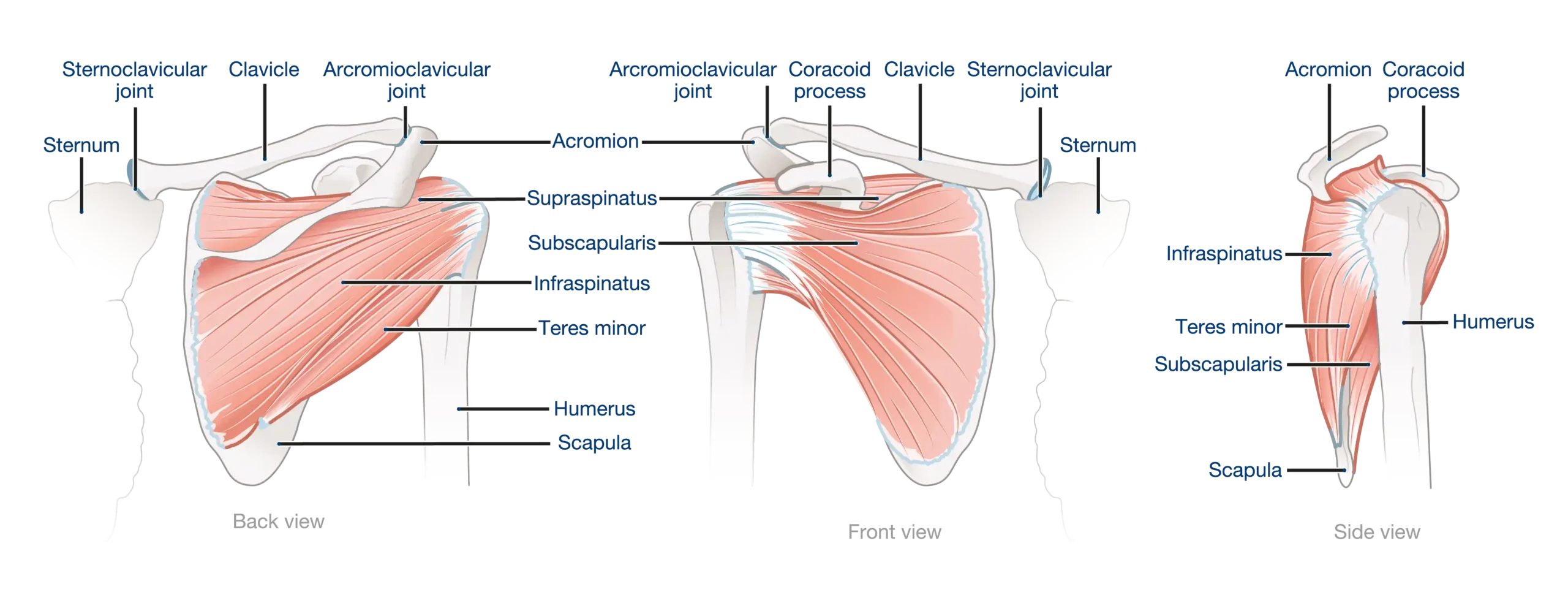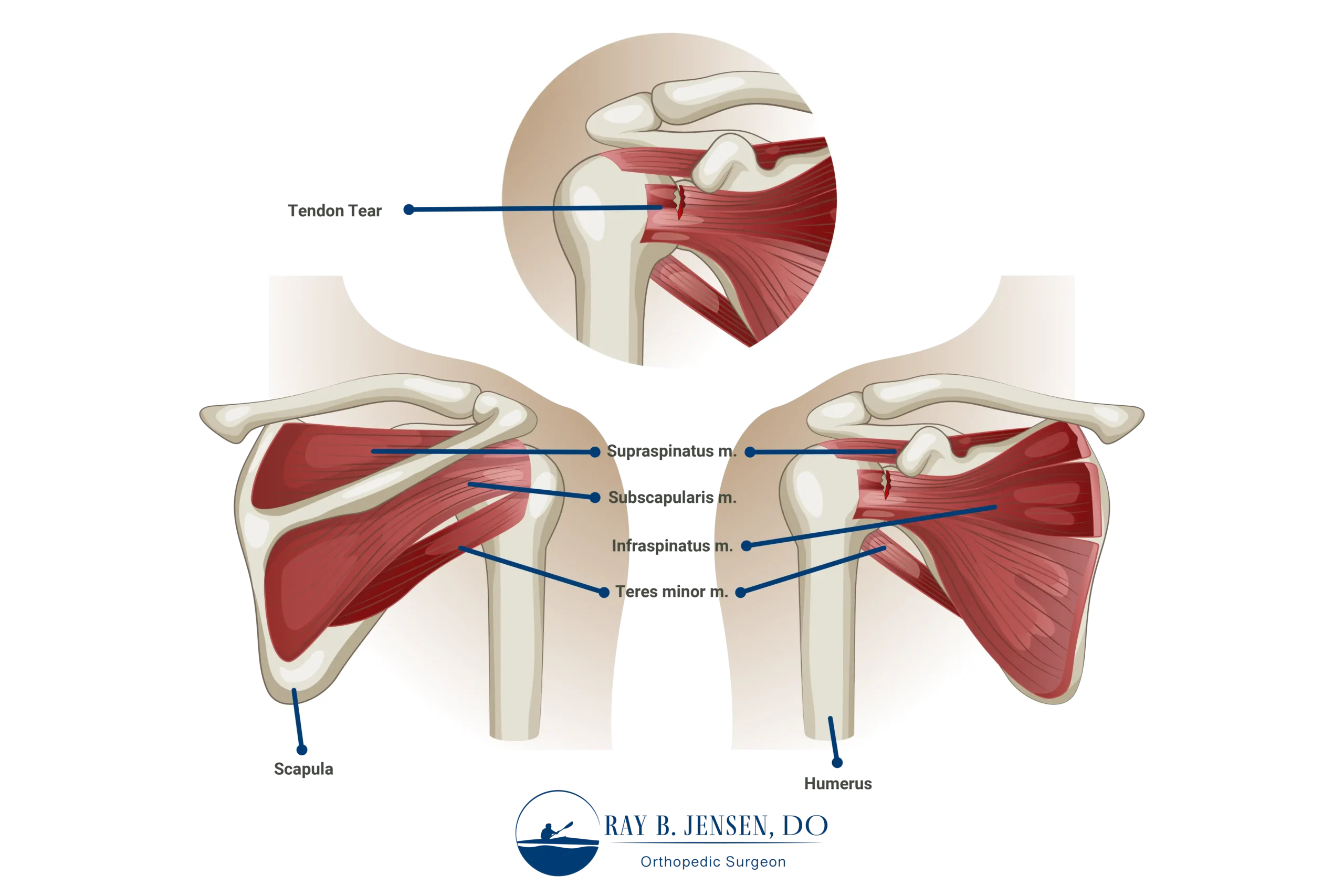A rotator cuff tear can cause shoulder pain and limit your arm’s movement. This post will help you identify its symptoms, understand the causes, and explore treatment options.
Key Takeaways
- The rotator cuff is vital for shoulder stability and mobility, consisting of four key muscles and their tendons.
- Rotator cuff tears can arise from repetitive overhead activities, trauma, and degenerative changes, with age being a significant risk factor.
- Treatment options for rotator cuff tears range from nonsurgical methods like physical therapy to surgical interventions, emphasizing the importance of a personalized rehabilitation plan for recovery.
Understanding the Rotator Cuff
The rotator cuff is a critican component of your shoulder’s anatomy, consisting of muscles and tendons that encompass the shoulder. These muscles and tendons are responsible for stabilizing the shoulder joint and allowing for a wide range of arm movements, such as lifting and rotating. The rotator cuff connects the upper arm bone to the shoulder blade, facilitating smooth and controlled motion.

Key to its function, the rotator cuff includes four essential muscles: the supraspinatus, infraspinatus, subscapularis, and teres minor. These muscles work in harmony to maintain shoulder stability and enable activities that involve lifting the arm overhead.
The tendons in the rotator cuff act as levers, transmitting the force generated by the muscles to move the shoulder bones. Understanding this intricate system underscores the importance of maintaining rotator cuff health to prevent injuries and ensure optimal shoulder function.
What is a Rotator Cuff Tear?
A rotator cuff tear occurs when one or more of the rotator cuff tendons are damaged or torn. The supraspinatus tendon is the most commonly affected, although any of the tendons can suffer from a tear. Tears can vary in severity, ranging from minor partial tears caused by overuse to complete ruptures resulting from traumatic events like shoulder dislocation or heavy lifting, including a rotator cuff injury and tendon tears.

Rotator cuff tears can lead to significant shoulder pain, rotator cuff pain, weakness, and instability, severely impacting daily activities. Even simple tasks like brushing your hair or reaching for an object can become challenging. The tear can cause a persistent dull ache in the shoulder, which often worsens at night, making it difficult to sleep.
These injuries are part of a broader spectrum of rotator cuff disease, which includes partial tear thickness tears and full thickness tears. Full thickness tears often occur without trauma and can be due to degenerative changes over time. Understanding the nature and extent of the tear is crucial for determining the most effective treatment plan.
Causes of Rotator Cuff Tears
Rotator cuff tears often result from repetitive overhead activities, which can gradually wear down the tendons. Sports like tennis and swimming, which involve repetitive shoulder motions, are common culprits. Overuse injuries from these activities can create cumulative stress on the shoulder tendons, leading to minor tears that may worsen over time.
Trauma is another significant cause of rotator cuff tears. A fall or a direct blow to the shoulder can result in substantial damage to the rotator cuff. Additionally, as we age, degenerative changes in the tendons make them more susceptible to tears. These degenerative tears are often seen in individuals over 40 and are a natural part of the aging process.
Risk Factors for Rotator Cuff Tears
Age is one of the most significant risk factors for rotator cuff tears, with individuals over 40 being more susceptible. Men are generally at a slightly higher risk than women. Genetic factors can also play a role, making some individuals more prone to rotator cuff conditions.
Certain sports and occupations that involve repetitive shoulder motions can elevate the risk of rotator cuff injuries. Workers who frequently perform overhead movements, such as painters or carpenters, are particularly vulnerable.
Poor posture, especially rounded shoulders or slouching, can contribute to rotator cuff injuries by placing additional strain on the shoulder joint. Lifestyle factors like smoking, which negatively impacts tissue healing, and previous shoulder injuries also increase the risk.
Symptoms of a Rotator Cuff Tear
Shoulder pain is the most common symptom of a rotator cuff tear. It typically indicates the presence of an injury in that area. This pain can range from a sharp, acute pain following a traumatic injury to a persistent dull ache that worsens at night. The dull ache is often deep within the shoulder and can make it difficult to find a comfortable sleeping position.
Muscle weakness can be another prevalent symptom in patients with a symptomatic rotator cuff tear. This weakness can make it challenging to perform everyday tasks, such as lifting objects or combing your hair. The combination of rotator cuff tear symptoms, pain and arm weakness often leads individuals to seek medical attention and treatment.
Diagnosing a Rotator Cuff Tear
Diagnosing a rotator cuff tear diagnosed involves a thorough clinical history and physical examination. The medical history helps the orthopedic shoulder surgeon understand the patient’s symptoms, previous injuries, and overall health status. During the physical examination, specific tests are conducted. These tests aim to assess the presence, location, and extent of the tear.
Imaging techniques play an important role in confirming the diagnosis. Ultrasound (US) is typically the initial imaging method used to evaluate suspected rotator cuff injuries. If ultrasound results are inconclusive or if additional intra-articular pathology is suspected, magnetic resonance imaging (MRI) is often employed. Both ultrasound and MRI have shown comparable accuracy in detecting full-thickness rotator cuff tears.
It’s important to corroborate imaging results with clinical assessments to avoid false positives. The accuracy of ultrasound can be influenced by the operator’s skill and experience, emphasizing the importance of having these tests conducted by experienced professionals.
Treatment Options for Rotator Cuff Tears
Treating rotator cuff tears involves a range of options, including both nonsurgical and surgical methods. The choice of treatment depends on the severity of the tear, the patient’s age, activity level, and overall health.
These treatment options can be explored in more detail.
Nonsurgical Treatments
Nonsurgical treatments are often the first line of defense against rotator cuff tears. These treatments include rest, anti-inflammatory medications, and physical therapy to alleviate pain and improve function. Nonsteroidal anti-inflammatory drugs (NSAIDs), corticosteroid injections, and local anesthesia injections are commonly used to relieve pain.
Physical therapy plays an important role in nonsurgical treatment, involving heat application, stretching, and both passive and active range of motion exercises. Strengthening exercises and isometric exercises are also crucial in improving shoulder function and supporting recovery.
Overall, conservative treatments have shown significant clinical improvement in a majority of patients with rotator cuff tears.
Surgical Treatments
When nonsurgical treatments fail to provide relief or if the tear is severe, surgical intervention may be necessary. Arthroscopic surgery is the preferred method for repairing torn rotator cuff tendons due to its minimally invasive nature, which reduces tissue disruption and promotes faster recovery. In cases where the rotator cuff muscles have atrophied, muscle transfers can restore shoulder function.
Open tendon repair may be required for more complex repairs, especially if multiple tendons are involved. Additional surgical treatments for complete or some partial rotator cuff tears may include rotator cuff repair and acromioplasty. The choice of surgical procedure depends on the specific needs of the patient and the extent of the injury.
Recovery and Rehabilitation
Successful rehabilitation after rotator cuff surgery hinges on engaging with a skilled physical therapist. Physical therapy involves a combination of stretching and strengthening exercises specifically designed for shoulder recovery. The recovery process often follows four distinct phases, each targeting different aspects of recovery.
The first phase focuses on passive range of motion to gently stretch the shoulder, while the second phase introduces active-assisted and active range of motion exercises. Initial strengthening exercises begin in the third phase, targeting the rotator cuff and surrounding shoulder muscles. The final stage aims to build shoulder strength, incorporating more intense exercises and sport-specific activities.
Preventing Rotator Cuff Tears
Prevention is always better than cure, especially when it comes to rotator cuff tears. Regular shoulder exercises and proper warm-ups, like gentle stretching, can enhance the strength of the rotator cuff and reduce the risk of injury. Incorporating exercises that strengthen the rotator cuff muscles is critical for maintaining shoulder stability.
Maintaining good posture is another key preventive measure. Proper shoulder blade posture ensures proper shoulder alignment, reducing the likelihood of rotator cuff injuries. Additionally, modifying lifting techniques and exercise routines can significantly lower the risk of shoulder injuries.
These preventive strategies help maintain healthy shoulder function for anyone.
Summary
Rotator cuff tears are a common but manageable condition. Understanding the anatomy and function of the rotator cuff, recognizing the symptoms, and knowing the treatment options are crucial steps toward recovery. Whether through nonsurgical treatments or surgical intervention, there is hope for those suffering from rotator cuff injuries. Early diagnosis and appropriate treatment can lead to a full recovery and a pain-free life.
Frequently Asked Questions
What is a rotator cuff tear?
A rotator cuff tear refers to a tear in one of the tendons of the rotator cuff, most frequently involving the supraspinatus tendon. It typically leads to pain and limited shoulder movement, impacting daily activities.
What are the common symptoms of a rotator cuff tear?
Common symptoms of a rotator cuff tear include shoulder pain, weakness, and a persistent dull ache that often worsens at night. Prompt recognition of these symptoms is essential for effective treatment.
How is a rotator cuff tear diagnosed?
A rotator cuff tear is diagnosed through a thorough clinical history and physical examination, complemented by imaging techniques such as ultrasound or MRI for a comprehensive assessment.
What are the treatment options for rotator cuff tears?
For rotator cuff tears, treatment options include nonsurgical approaches such as NSAIDs and physical therapy, as well as surgical options like arthroscopic repair, depending on the severity of the tear. Choosing the right approach is crucial for effective recovery.
How can rotator cuff tears be prevented?
To prevent rotator cuff tears, focus on regular shoulder exercises, ensure proper warm-up routines, maintain good posture, and utilize correct lifting techniques. Staying proactive in these areas can significantly reduce your risk of injury.



